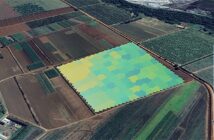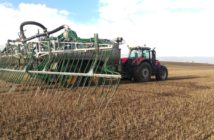Considering the current pricing of crop nutrition, growers are being advised to ensure that all available nutrients are at an optimal level to maximise nitrogen uptake. Natalie Wood, Agronomy operations manager at Yara, shared her thoughts.
“We need to focus on nutrient use efficiency as a whole, rather than solely considering nitrogen,” says Mrs Wood. “If you’re deficient in N, then applications can be made. However, that N won’t be used efficiently unless other nutrients are at an optimal level. Foliar applications of the right products can help you get there.”
With the right nutrients in place, growers can ensure the plant is able to efficiently take up N when it comes into contact. What nutrients are key here? Mrs Wood recommends growers focus on magnesium, phosphate, and potassium.
“At this time of year, phosphate is not readily available from the soil,” says Mrs Wood. “If you’re going on with NPK as a first application, it won’t reach the plant immediately; it takes time to naturally break down. To remedy this, we recommend applying a foliar product.”
Energy drink for the crop
A foliar fertiliser with a high concentration of phosphate together with potash and magnesium –acts as a kick-starter, almost like an energy drink for the crop. “Getting this on quickly after the first fertiliser application helps stimulate growth ensuring the plant is ready to maximise the benefit of that first application.”
The availability of phosphate is crucial, as it is a vital part of the “energy unit” of the plant, stimulating growth. As the crop has not been able to access phosphate within the soil, starting it off with a foliar product – even in minimal amounts – helps kickstart growth and ensures the plant maximises applied nutrition.
Phosphate also plays a crucial role in helping roots and shoots to grow effectively and facilitating efficient energy transfer within the plant. “In terms of when to apply phosphate, you would generally wait perhaps a week after your first NPK application,” says Mrs Wood. “As always, take seasonal conditions into account.”
The purpose of this timing will ensure the plant is stimulated to grow while searching for additional nutrients. “Even if phosphate is coming from both the leaf and the roots at the same time it’s not an issue,” says Mrs Wood. “Ultimately, we’re attempting to improve uptake of nutrients that you’ve applied in the soil. A foliar application helps make that happen.”
“Leaf tissue testing will let you know any key nutrients that you need to apply later in the season,” says Natalie. “You can apply a cover-all product that contains multiple nutrients – this is definitely a good idea. Of course, in an ideal world, you would perform a test before T1 and apply a product like that as well, assuming you’ve got no major deficiencies. If you do have a major deficiency, you might need to go with straights.”
“As an analogy, a multi-vitamin won’t give you enough calcium if you are specifically deficient in it. You would have to take a calcium-specific product.”
Mrs Wood returns to the principle of Liebig’s barrel, often used to convey the holistic approach required for optimal crop nutrition:
“We don’t want any limiting factors,” adds Mrs Wood. “Liebig’s barrel is a useful way of illustrating this. Consider a normal barrel, with each of the wooden planks that compose it representing a different nutrient. If just one of those is too low, the water in the barrel will leak out.”




